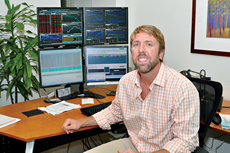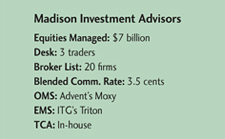When an order hits the blotter, traders need to come up with a strategy. Ultimately, the decision will be to either trade high touch through a sellside desk, or to go the low-touch route and do it themselves.

For David DeVito, CMT, the head trader at Madison Investment Advisors, he chooses to trade low touch for about 75 percent of his order flow. A former Nasdaq market maker at Citi, DeVito is an unabashed fan of low touch. It’s faster and more efficient, and avoids miscommunication, he says, but most importantly, it cuts down on leakage. Beyond that, he’s got the same tools as brokers, and since he knows the portfolio manager’s intentions, he thinks he’s in a better position to pull the trigger on trades.
"The sellside getting their hands dirty in the actual trading doesn’t make sense to me any more, unless they have liquidity," DeVito says. Still, he values his sellside relationships. They provide useful "trading specific research" that makes him a better trader, he says. For example, DeVito wants to know how activity in other asset classes in global markets is affecting equities. "I need them," he says. "They are my ear to the Street."
DeVito has about half a dozen go-to brokers whose high-touch desks he interacts with to get their reads on the market. "To have experts consolidate the complexities of today’s market for you adds tremendous value," he says.
Of course, liquidity is another key factor in any broker relationship, and if a firm can provide block liquidity, then count DeVito in. Madison, which manages $7 billion in equities, is a low-turnover shop and features concentrated portfolios of between 30 and 35 names. Consequently, its orders can be "chunky," particularly for mid-cap stocks, he says.
DeVito, a 14-year veteran, doesn’t rely on capital and favors natural flow from IOIs or the electronic venues. Madison isn’t a big consumer of Street research, either, he adds. For all research trades, however, brokers receive the same 4 cents a share, whether it’s a voice or an electronic trade. "We don’t differentiate based on venue," DeVito says. "If high touch is adding value, we’ll go there. If not, our default is low touch."

After graduating from Marist College, DeVito took a job on the buyside at Brown Brothers Harriman in 1997. Four years later, he landed on Citi’s Nasdaq desk. He called the experience an "eye opener" because Citi threw around a lot of capital and was the axe in a number of big names like WorldCom, he says. After receiving his MBA from New York University, DeVito moved to Curian Capital in Denver, then a startup. He joined employee-owned Madison in the Wisconsin capital five years ago.
DeVito says a buyside shop has to "walk a fine line between the electronic and the high-touch worlds." He knows that regardless of how much in commissions Madison pays a firm, if it doesn’t trade upstairs, it won’t get the information flow to add alpha. "I wish there were an electronic sales trader," DeVito says, "someone who concentrated on trading desk research and news flow."



